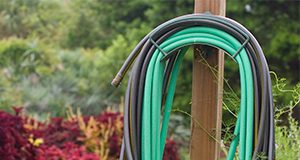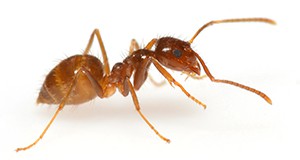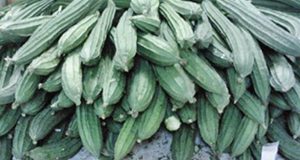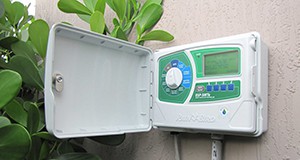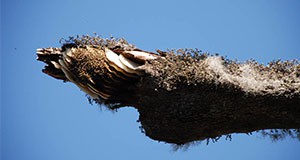Water pollution and drought in the United States have made water scarcity a widespread concern. Currently, residential consumers account for most urban water use, and meaningful programs that lead to water conservation rely on a comprehensive understanding of how consumers use water inside and outside their homes. This 5-page fact sheet written by Hayk Khachatryan, Alicia Rihn, and Michael Dukes and published by the Department of Food and Resource Economics outlines University of Florida researchers’ assessments of current US household indoor and outdoor water use to assist policy makers and researchers with creating incentives for homeowners to conserve water.
http://edis.ifas.ufl.edu/fe996
Category: House & Home
Integrated Pest Management (IPM) of the Tawny Crazy Ant, Nylanderia fulva (Mayr)
The tawny crazy ant infests buildings and greenhouses, attacks crops, domestic animals, and honeybee hives, displaces native ant species, and disrupts electrical equipment. This 8-page fact sheet describes how to identify the ant and monitor for infestations. It explains how to eliminate food sources and harborages and presents an integrated pest management plan and specific approaches to control this pest ant. (Note: the tawny crazy ant is a serious pest that multiplies quickly and can easily become an overwhelming problem. If you suspect you have tawny crazy ants, the best approach is to call a licensed pest-control professional for help). Revised by Faith Oi, Dawn Calibeo, John Paige III, and Michael Bentley and published by the UF Department of Entomology and Nematology.
http://edis.ifas.ufl.edu/in889
Luffa: an Asian Vegetable Emerging in Florida
Luffa is the genus name of several tropical and subtropical plants in the cucumber family. Alternatively spelled “Loofa” or “Loofah,” the name is derived from the plant’s use as a material for sponges and dish cloths for bathing and cleaning dishes. This six page fact sheet describes the two types of Luffa, how to cultivate them, and what they can be used for. Written by Yucong Xie, Guodong Liu, Yuncong Li, and Kati Migliaccio and published by the Horticultural Sciences Department.
http://edis.ifas.ufl.edu/hs1285
Grandparents Raising Grandchildren: Custody Options
 Grandparents have several custody options when they are caring for their grandchildren. To decide which options match your needs, you must become familiar with legal terms. This brochure provides information on custody options, situation scenarios, and legal resources. Written by Larry F. Forthun and Millie Ferrer-Chancy with assistance from the Legal Aid Foundation, and published by the UF Department of Family, Youth and Community Sciences. Revised December 2015.
Grandparents have several custody options when they are caring for their grandchildren. To decide which options match your needs, you must become familiar with legal terms. This brochure provides information on custody options, situation scenarios, and legal resources. Written by Larry F. Forthun and Millie Ferrer-Chancy with assistance from the Legal Aid Foundation, and published by the UF Department of Family, Youth and Community Sciences. Revised December 2015.
http://edis.ifas.ufl.edu/fy433
Fall Prevention: Home Safety Inventory
 Most falls occur in the home, so it is wise to take time to do a home safety inventory. This 2-page fact sheet is a major revision that can be used to identify problem areas in your home. Written by Linda B. Bobroff, and published by the UF Department of Family, Youth and Community Sciences, revised July 2016.
Most falls occur in the home, so it is wise to take time to do a home safety inventory. This 2-page fact sheet is a major revision that can be used to identify problem areas in your home. Written by Linda B. Bobroff, and published by the UF Department of Family, Youth and Community Sciences, revised July 2016.
http://edis.ifas.ufl.edu/fy735
Frequently Asked Questions About Huanglongbing (HLB; citrus greening) for Homeowners
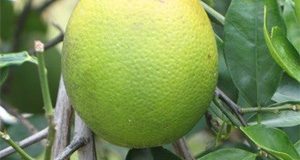
Huanglongbing (HLB), also known as citrus greening, is a serious bacterial disease that affects citrus in Florida. Florida residents enjoy growing citrus for a variety of reasons, but growing citrus in today’s disease climate is not an easy task. This seven-page document is designed to help Master Gardeners and homeowners answer commonly asked questions about HLB. Written by Brooke L. Moffis, Jamie D. Burrow, Megan M. Dewdney, and Michael E. Rogers and published by the Plant Pathology Department.
http://edis.ifas.ufl.edu/pp326
Pest Strips: You Have to Read the Fine Print
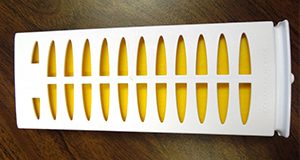
Pest strips are commonly sold at many retail outlets and are available to anyone for purchase. They are constructed of resin plastic with an insecticide that is gradually control-released over time as a vapor. This two-page fact sheets gives important tips on how to use pest strips correctly without creating a hazard.Written by Fred Fishel and published by the Agronomy Department.
http://edis.ifas.ufl.edu/pi262
Choosing a Licensed Wood-Destroying Organism (WDO) Inspector
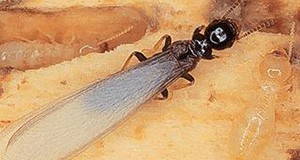
A wood-destroying organism inspection is a visual inspection performed by a licensed pest control inspector trained to identify evidence of termites, powderpost beetles, and other organisms that chew on wood and cause damage to property. Home buyers and sellers, real estate professionals, and lending institutions order these inspections before real estate transactions. This 4-page fact sheet written by Faith M. Oi, Paul Mitola, Kathleen Ruppert, Michael Page, and Mark Ruff and published by the Entomology and Nematology Department explains how to select an inspector who is licensed and certified so that you can be confident in the inspection.
edis.ifas.ufl.edu/IN629
Do-It-Yourself Insect Pest Traps

Many types of traps can be used to monitor or control insect pests. Traps to capture insects vary greatly, depending on the target, location, and purpose. Traps may be inexpensive and disposable, or more complex. This 12-page fact sheet describes several traps for common pests in the home, garden, and landscape that can be made using common household materials or that are readily available in stores. Written by Steven Arthurs and Adrian Hunsberger and published by the Entomology and Nematology Department.
http://edis.ifas.ufl.edu/in1103
Contaminants in the Urban Environment: Microplastics
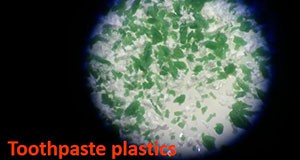
Plastic, plastic everywhere! We live in a world where we are surrounded by plastic: from packaging materials and cutlery to plastic appliances and medical devices. Since the mid-twentieth century, plastic has been a boon to humanity and an integral part of our modern lives. However, plastic debris is a major concern due to its abundance and persistence in the environment. Plastic contaminants not only include plastic debris characterized by large size but also small pieces of plastic in the millimeter size range; these inconspicuous “microplastics” have become a major concern because of their widespread presence in different environments and diverse organisms. This six-page fact sheet discusses the sources of microplastics, their effects on the environment, and ways to minimize microplastics pollution and exposure. Written by Yun-Ya Yang, Ignacio A. Rodriquez, Maia McGuire, and Gurpal S. Toor, and published by the Soil and Water Science Department.
http://edis.ifas.ufl.edu/ss649
Contaminants in the Urban Environment: Bisphenol-A
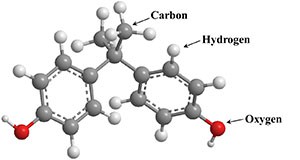
Bisphenol-A (BPA) is a man-made chemical widely used as a component in many products of daily use in households, such as plastic bottles and metallic canned foods. BPA can leach from bottles and cans into the environment, increasing our exposure to BPA. BPA is known to harm exposed animals in laboratory settings as well as in the wild, although its potential to harm humans remains controversial. This seven-page fact sheet will discuss the occurrence, use, and potential harmful effects of BPA and will suggest ways to reduce human and environmental exposure to BPA. Written by Ignacio A. Rodriquez-Jorquera, Yun Ya Yang, and Gurpal S. Toor and published by the Soil and Water Science Department.
http://edis.ifas.ufl.edu/ss648
Frequently Asked Questions about Soil Moisture Sensor Irrigation Controllers (SMS)
![]()
A soil moisture sensor (SMS) is a device that detects how much moisture is in the soil and prevents an irrigation system from running when it is not needed. This 4-page fact sheet written by Paul Monaghan, Ondine Wells, Michael Dukes, Maria Morera, and Laura Warner and published by the Department of Agricultural Education and Communications explains how the technology functions as well as how to install, program, operate, and maintain an SMS for a money- and water-wise sustainable home landscape that’s lush and beautiful.
http://edis.ifas.ufl.edu/wc238
Frequently Asked Questions about Evapotranspiration (ET) Irrigation Controllers
Evapotranspiration is the amount of water that is released into the atmosphere through evaporation and plant transpiration. An evapotranspiration irrigation controller is a device that uses data about the landscape, the type of irrigation system, and local weather conditions to determine when and how much to irrigate. This 5-page fact sheet written by Paul Monaghan, Ondine Wells, Michael Dukes, Maria Morera, and Laura Warner and published by the Department of Agricultural Education and Communications explains how the technology functions as well as how to install, program, operate, and maintain an ET controller for a money- and water-wise sustainable home landscape that’s lush and beautiful.
http://edis.ifas.ufl.edu/wc237
Consejos para pleanear contra desastres para gente mayor
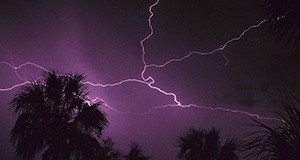 FY1462 is the Spanish language version of FY620, Disaster Planning Tips for Older Adults. This 4-page publication offers an abundance of information pertaining to water storage and use, food, first aid, important papers, electronics, medical needs, stress reduction, and evacuation which can help older adults plan for natural disasters and other emergencies. Written by Carolyn Wilken, Linda B. Bobroff, and Emily Minton, and published by the Department of Family, Youth and Community Sciences, May 2003.
FY1462 is the Spanish language version of FY620, Disaster Planning Tips for Older Adults. This 4-page publication offers an abundance of information pertaining to water storage and use, food, first aid, important papers, electronics, medical needs, stress reduction, and evacuation which can help older adults plan for natural disasters and other emergencies. Written by Carolyn Wilken, Linda B. Bobroff, and Emily Minton, and published by the Department of Family, Youth and Community Sciences, May 2003.
http://edis.ifas.ufl.edu/fy1462
Hurricane Preparation: Evacuating Your Home
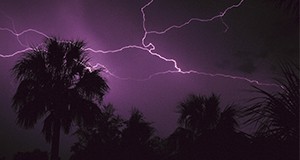
Every year Floridians are faced with the possibility of hurricanes. Hurricanes have had devastating effects on many communities in Florida, and every year the possibility exists that communities will be hit by hurricanes during the summer and fall months. During the months of potential hurricanes, it is important to plan for the worst and hope that it never happens. For example, you and your family may be asked to leave your home due to some emergency conditions in your community. Have a plan for a possible evacuation and be prepared to evacuate. This 3-page fact sheet lists fifteen things to keep in mind. Written by Elizabeth Bolton and Muthusami Kumaran and published by the Department of Family, Youth and Community Sciences, May 2015.
http://edis.ifas.ufl.edu/fy747
Estimated Water Savings Potential of Florida-Friendly Landscaping™ Activities
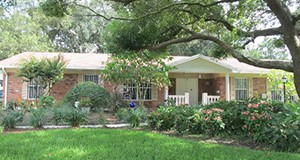
To help homeowners predict the impact of implementing some of the water conservation measures listed on Florida-Friendly Landscaping™ checklist, this 5-page fact sheet offers a table of estimated water savings. Homeowners can select activities which are the best fit for their landscape and can also see which have the most conservation potential. The water savings is compared to a baseline case of typical irrigation behavior. This 5-page fact sheet was written by Mackenzie Boyer and Michael Dukes, and published by the UF Department of Agricultural and Biological Engineering, August 2015. (Photo credit: Michael Gutierrez, UF/IFAS)
http://edis.ifas.ufl.edu/ae515
Basics of the National Flood Insurance Program
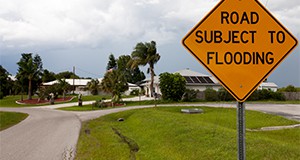
Established by Congress in 1968 because the private market stopped offering flood insurance, the NFIP provides federally backed flood insurance to property owners in participating communities. This 10-page fact sheet covers topics such as: why buy flood insurance, recent changes, flood zones and insurance rate maps, ways to reduce premiums, rate increases for pre-1974 structures, and actions communities can take to lower citizen premiums related to climate change and sea-level rise. Written by Thomas Ruppert and published by the UF Department of Sea Grant, July 2015.
http://edis.ifas.ufl.edu/sg139
Contaminantes en el Medio Ambiente Urbano: Los Perfluoroalquilos
 Los perfluoroalquilos–los perfluorocarbonos (PFC) o, en inglés, perfluoroalkyl substances (PFASs)–son los productos químicos artificiales más comunes y persistentes en el planeta. Algunos de los productos más comunes que contienen perfluoroalquilos son sartenes de teflón, utensilios de cocina antiadherente, chaquetas impermeables (como Gore-Tex), espumas de extinción de incendios, envases de alimentos, alfombras y telas para muebles. Los perfluoroalquilos poseen un largo tiempo de residencia en el medio ambiente, lo que significa que los perfluoroalquilos pueden acumularse en los organismos en niveles que causan efectos nocivos.
Los perfluoroalquilos–los perfluorocarbonos (PFC) o, en inglés, perfluoroalkyl substances (PFASs)–son los productos químicos artificiales más comunes y persistentes en el planeta. Algunos de los productos más comunes que contienen perfluoroalquilos son sartenes de teflón, utensilios de cocina antiadherente, chaquetas impermeables (como Gore-Tex), espumas de extinción de incendios, envases de alimentos, alfombras y telas para muebles. Los perfluoroalquilos poseen un largo tiempo de residencia en el medio ambiente, lo que significa que los perfluoroalquilos pueden acumularse en los organismos en niveles que causan efectos nocivos.
This 6-page fact sheet is the Spanish language version of Contaminants in the Urban Environment: Perfluoroalkyl Substances, written by Ignacio A. Rodriguez-Jorquera and Gurpal S. Toor, and published by the UF Department of Soil and Water Science, June 2015.
http://edis.ifas.ufl.edu/ss644
Feature image credit: iStock/Thinkstock.com (non-stick pan, waterproof fabric, and fire fighting foam)/Digital Vision/Thinkstock.com (fast food)
Tawny Crazy Ant
As of 2012, tawny crazy ants have invaded 24 counties in Florida, parts of southeast Texas, and other areas of the southeastern U.S. The tawny crazy ant is considered a series pest. This species infests buildings and greenhouses, attacks crops, domestic animals, honeybee hives, displaces native ant species, and disrupts electrical equipment. This 3-page fact sheet covers the tawny crazy ant’s distribution, description, colonies, feeding habits, and pest status and control. Written by S. K. Hill, R. W. Baldwin, R. M. Pereira, and P. G. Koehler, and published by the UF Department of Entomology and Nematology, October 2013.
http://edis.ifas.ufl.edu/in1076
African Honey Bee: What You Need to Know
African honey bees entered the United States in the early 1990s and have since spread throughout the Southwest and Southeast, including parts of Florida. Compared to European bees, African bees are highly aggressive when disturbed and are more likely to sting humans and animals. This 6-page fact sheet covers the history and distribution of African honey bees in the Americas and explains how beekeepers and residents can manage their interactions with these bees. Written by H. Glenn Hall, Catherine Zettel-Nalen and James D. Ellis, and published by the UF Department of Entomology and Nematology, December 2014. http://edis.ifas.ufl.edu/mg113
